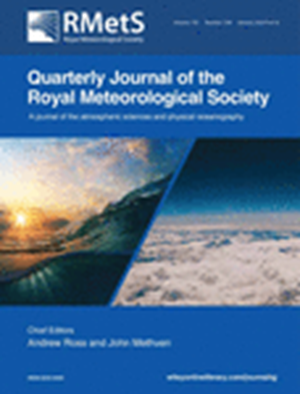为非连续伽勒金模型量身定制数据同化方法
IF 3
3区 地球科学
Q2 METEOROLOGY & ATMOSPHERIC SCIENCES
引用次数: 0
摘要
近年来,非连续伽勒金(DG)方法越来越受到地球物理学界的关注。在这些方法中,每个网格单元的解被近似为基函数的线性组合。集合数据同化(DA)的目的是利用从模型运行集合中估算出的误差统计数据,将模型输出与观测数据结合起来,从而近似真实状态。地球物理模型中的集合数据同化面临着几个有据可查的问题。在这项工作中,我们利用 DG 基函数中的求解扩展来解决其中的一些问题。具体来说,我们研究了 DA-DG 组合是否(a)减轻了观测稀化的需要,(b)减少了场梯度的误差,以及(c)可用于建立与尺度相关的定位。利用随机生成的具有不同噪声特性的模型状态集合,并使用 Legendre 多项式作为基函数,进行了数值实验。实验发现,使用 DA-DG 可以大大降低分析误差,而且随着 DG 阶数的增加,分析误差也会增加。当小尺度误差主导背景误差时,情况尤其如此。另一方面,DA 对一阶导数的改进微乎其微。我们认为这是 DG 密切拟合观测数据的能力所产生的反作用,因为这可能会恶化导数的估计值。对不同的多项式阶数进行优化定位,从而利用其不同的空间长度,是有益的:它所得到的协方差矩阵比传统的状态空间优化定位矩阵更接近真实的协方差。本文章由计算机程序翻译,如有差异,请以英文原文为准。
Tailoring data assimilation to discontinuous Galerkin models
In recent years discontinuous Galerkin (DG) methods have received increased interest from the geophysical community. In these methods the solution in each grid cell is approximated as a linear combination of basis functions. Ensemble data assimilation (DA) aims to approximate the true state by combining model outputs with observations using error statistics estimated from an ensemble of model runs. Ensemble data assimilation in geophysical models faces several well‐documented issues. In this work we exploit the expansion of the solution in DG basis functions to address some of these issues. Specifically, it is investigated whether a DA–DG combination (a) mitigates the need for observation thinning, (b) reduces errors in the field's gradients, and (c) can be used to set up scale‐dependent localisation. Numerical experiments are carried out using stochastically generated ensembles of model states, with different noise properties, and with Legendre polynomials as basis functions. It is found that strong reduction in the analysis error is achieved by using DA–DG and that the benefit increases with increasing DG order. This is especially the case when small scales dominate the background error. The DA improvement in the first derivative is, on the other hand, marginal. We think this to be a counter‐effect of the power of DG to fit the observations closely, which can deteriorate the estimates of the derivatives. Applying optimal localisation to the different polynomial orders, thus exploiting their different spatial length, is beneficial: it results in a covariance matrix closer to the true covariance than the matrix obtained using traditional optimal localisation in state space.
求助全文
通过发布文献求助,成功后即可免费获取论文全文。
去求助
来源期刊
CiteScore
16.80
自引率
4.50%
发文量
163
审稿时长
3-8 weeks
期刊介绍:
The Quarterly Journal of the Royal Meteorological Society is a journal published by the Royal Meteorological Society. It aims to communicate and document new research in the atmospheric sciences and related fields. The journal is considered one of the leading publications in meteorology worldwide. It accepts articles, comprehensive review articles, and comments on published papers. It is published eight times a year, with additional special issues.
The Quarterly Journal has a wide readership of scientists in the atmospheric and related fields. It is indexed and abstracted in various databases, including Advanced Polymers Abstracts, Agricultural Engineering Abstracts, CAB Abstracts, CABDirect, COMPENDEX, CSA Civil Engineering Abstracts, Earthquake Engineering Abstracts, Engineered Materials Abstracts, Science Citation Index, SCOPUS, Web of Science, and more.

 求助内容:
求助内容: 应助结果提醒方式:
应助结果提醒方式:


